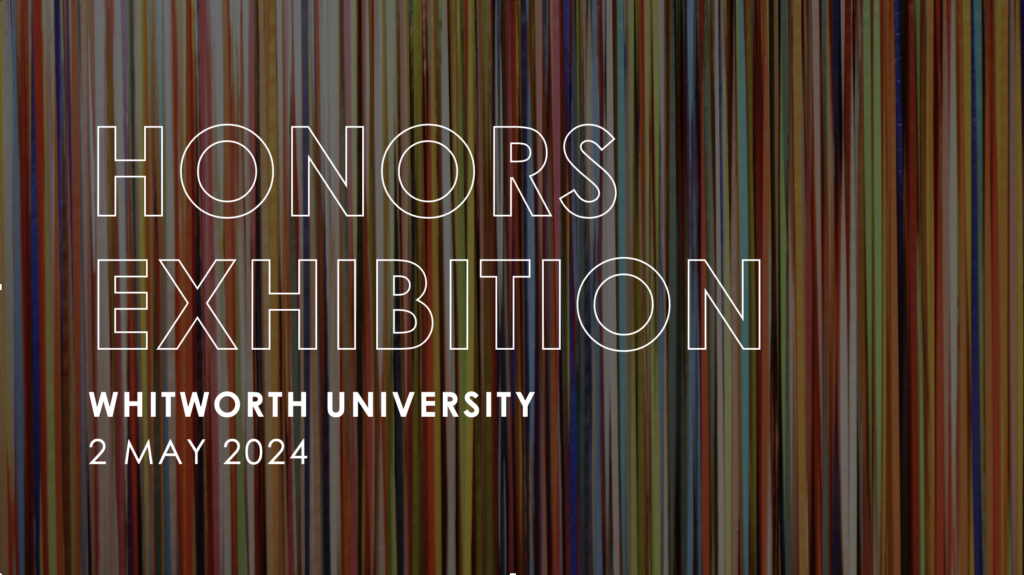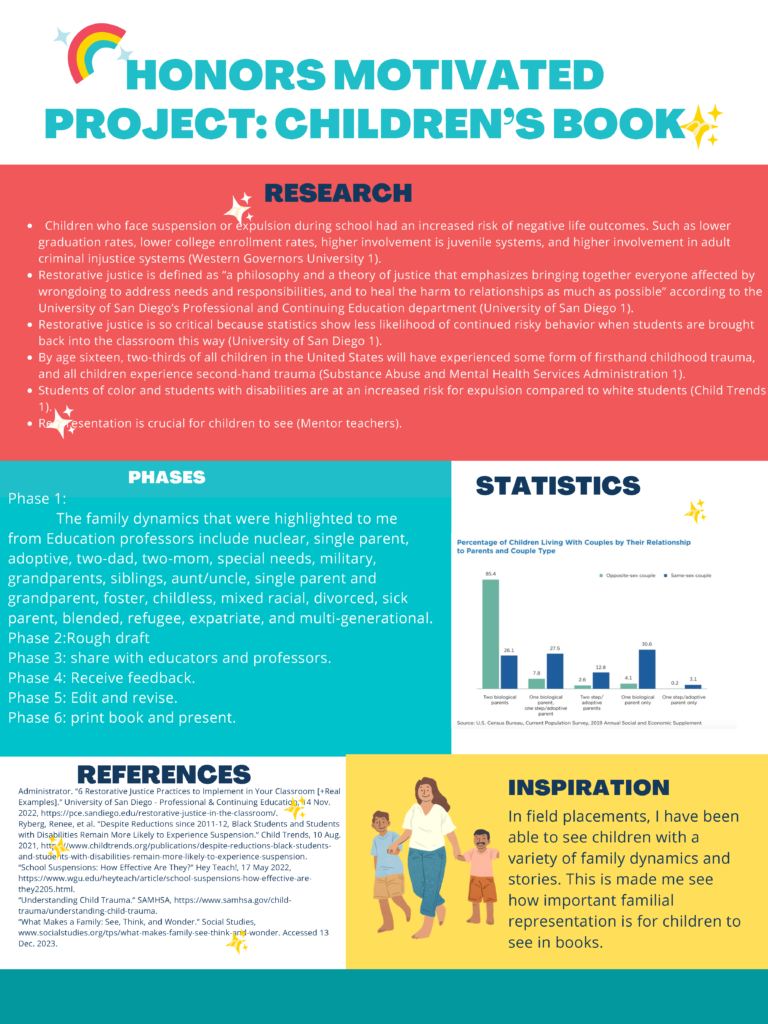
HAILEY NASS
Class of 2025. Elementary Education Major.
I come from a family of teachers and have always been drawn to helping people. I am so grateful for the way my parents have always supported me, loved me, guided me, and raised me to value my family. I love learning about people, along with their families and experiences. My ultimate goal is to help people feel loved. I believe that with love, we can face anything and rise out of any adversity. I hope these books can start this mission of mine.

Belonging, Representation, Empathy – a Children’s Book
Book Proposal
I have always been fascinated by humans. I just love learning about others. I think diversity is something to celebrate and be proud of. Understanding that we all come from such unique backgrounds and experiences is truly a beauty and a wonder to me. However, I know that unfortunately, there are a lot of stigmas surrounding what makes a “good” household for a child to be raised in. While I believe this is an important question, what I have found is that society often blames the family dynamic or structure over the actual child to caregiver relationship. For example, a common stigma is that a nuclear family structure produces intelligent, caring, thoughtful children, while a divorced family creates children that have anger issues, lack discipline, and engage in risky behaviors. These stereotypes are engrained into society which means they are ingrained into children’s thinking when they are simply not true. These stereotypes lack evidential support of any kind and ignore the fact that any family dynamic can hurt a child, but more so, any family dynamic can help a child grow to be kind, intelligent, honest, brave, and selfless. My intention for this book is to teach children how to respond to discrimination they may face, due to the family structure they are being raised in. Another intention is for children to see themselves in the stories, therefore, building representation. Lastly, my intention for this book is to help children and adults grow empathy for people whose story and family looks different than their own. If there is one thing I believe this world needs more of, it is love. I intend for this book to generate love for self, family, and others.
This passion grew about when I was observing a fourth-grade class. The children were completing math and English language arts assignments on their computers. They were also socializing. I noticed that there was a note being passed around the classroom. I had been in this same class for multiple weeks and knew that note passing had become an issue. So, I approached a student who had the note and asked to see it. The student informed me that it was not their note but belonged to another student. I looked at the note and was heart-broken at what I saw. It was titled “kill” followed by a list of student’s names from the class. I would not expect to see this from any student, but especially not the student that I was told wrote the note. I turned it into my mentor teacher who took it to the principal right away. The principal was fearful and did not know this student well, as this was the principal’s first year at the school. He made the decision to expel the student for two weeks. I can only imagine how hard this decision would be for any administrator. The principal was fearful for other student’s safety, which is justifiable. However, I do not think expulsion is the answer. Clearly this student was struggling with their mental health and social emotional learning. Children do not think in this way or write things like this unless there is an underlying trauma. Expulsion though further inflicts a deterioration in mental health and social emotional learning. Expulsion not only makes for missed opportunities to further learning, but it creates a label. Children are incredibly observant and notice when their peer has been gone from school. They are also very intuitive and read body language well. Given this case, administrators and school counselors did enter the classroom to observe dynamics between students. With that in mind, on top of noticing which student was missing, it is very likely that the other students knew parts of the situation. This makes it really difficult for the expelled student to come back into the classroom and feel safe. Plus, statistics show that children who face suspension or expulsion during school had an increased risk of negative life outcomes. Such as lower graduation rates, lower college enrollment rates, higher involvement is juvenile systems, and higher involvement in adult criminal injustice systems (Western Governors University 1). We need to incorporate restorative justice in these times.
Restorative justice is defined as “a philosophy and a theory of justice that emphasizes bringing together everyone affected by wrongdoing to address needs and responsibilities, and to heal the harm to relationships as much as possible” according to the University of San Diego’s Professional and Continuing Education department (University of San Diego 1). The concept is increasing in popularity and for all the right reasons. Restorative justice has the power to bring people together, to show compassion. In reference to Kohlberg’s six stages of moral development, utilizing restorative justice and practicing it is a level six action. In which, one is doing the right thing simply because it is the right thing. Not following the law necessarily, rather following moral principles and values because these are what truly make positive change. Restorative justice is so critical because statistics show less likelihood of continued risky behavior when students are brought back into the classroom this way (University of San Diego 1). Restorative justice builds a sense of community and belonging, It makes students feel known, seen, heard, respected, forgiven. It helps students understand that every day is a new day, a chance to start over. It also helps students realize that they are not a terrible person. We all make mistakes, and we can all grow from them. But we also all deserve grace, especially at such a young age when we still are trying to figure out our emotions and how to process them. Children are so resilient and go through so much more than we can even begin to grasp. Studies show that by age sixteen, two-thirds of all children in the United States will have experienced some form of firsthand childhood trauma and all children experience secondhand trauma (Substance Abuse and Mental Health Services Administration 1). That is two out of every three children. Trauma looks different too. It could be anything between psychological, physical, or sexual abuse, community or school violence, witnessing or experiencing domestic violence, national disasters or terrorism, commercial sexual exploitation, loss of a loved one, refugee or war experience, military family stressors, physical or sexual assault, neglect, accidents, and illness, along with many other instances too. Trauma also does not discriminate against age, gender, religion, socio-economic status, race, language, ethnicity, etc. Anyone can be a victim.
I do not know everything about this student’s home life. However, after this incident, it just did not sit right with me that he faced expulsion without no real investigation prior to the decision. So, I wanted to meet with his school counselor and current teacher to gain a better understanding of the situation. I knew this student was a minority, coming from an Asian heritage. I also knew that his family is lower income. I learned that he comes from a single parent household, it is just him and dad at home. I also learned that this behavior has not been seen in his previous teacher’s classrooms. With all this in mind, it got me curious about what students face a greater risk of expulsion. According to Child Trends Organization, students of color and students with disabilities are at an increased risk for expulsion compared to white students (Child Trends 1). It was heartbreaking to read this statistic. Fact of the matter is that we as a country do still have deep racial stigma surrounding our everyday life and education is no exception. We also have deep-rooted stigma surrounding students with disabilities. I believe that every child is capable of learning and is more than worthy of love. Children deserve the ability to become the people that they want to be. After all, we all were once a child. What makes us different is what makes us beautiful and unique. It may be a cliché, but it is so true and something I think we need to embody more as a society. As previously mentioned, trauma can happen to any person and any child. Children do not act out for the sake of acting out. I believe there is always something that a child is fighting when they are acting out or doing something we deem inappropriate. They are trying to cope with their feelings, they are trying to communicate that their needs are not being met. It is our job to recognize this and give each child the peace and voice they deserve. We cannot fix everything, nor can we prevent trauma from happening. But we can be in the child’s corner, advocating for them and meeting their needs as best as we can. We can work to see the good in each child, believe in the good, and help that child see their goodness as well. Every child deserves a cheerleader and protector. I believe that supporting their family is one of the best ways to do so. Add to that giving them a sense of representation and belonging and we can begin to see a positive difference. That is what I strive for this book to achieve. I think a lot of childhood trauma can be tied back to generational trauma. When family members have faced discrimination, it impacts their child on top of any discrimination that child faces personally. If we want to reduce the negative impacts of childhood trauma, I think we need to look at how we treat and represent families.
In addition to this experience, my family’s story gave me inspiration for this project. My maternal grandmother, my Ama as I called her, was from Taiwan. My grandfather is from West Virginia and met my Ama when he was stationed for the Navy in Taiwan. They eventually got married and had two children in Taiwan before having to move to California. However, my grandfather was deployed so it was just my Ama and her two young children. My Ama had never left Asia. She did not speak English and she did not have anyone to help her translate. She was pregnant with my mother and had two young children to take care of. She knew she had to get a job to provide for her family but faced much discrimination for her accent and heritage. She was an immigrant and unfortunately, people shamed her for it. Being a military family is also difficult because creating bonds with others then having to leave is emotionally taxing. Through all the pain my Ama had to endure, she was able to make a friend. Her name was Susie. Susie was a neighbor who showed the upmost kindness and compassion to my Ama. She taught her English, helped her find a job, and helped her take care of her children while my grandfather was away. She was truly a blessing and embodies what it means to love others and meet them where they are. My Ama named my mother Susie, in honor of her dear friend.
We do not get to choose the family or life we are born into. Though we do get to choose how we embrace our experiences and use them to grow. We also get to choose how we love others. I think understanding is the first step to love. We cannot love others if we do not find the place in our heart to selflessly meet them where they are, look them in the eye, and learn to love and understand the many wonderful layers of their soul. Family is the greatest factor in raising children. When families do not feel loved by society, how are they going to raise children that love others? I believe that it is our duty to help and love as many people as we can in our one precious life. I believe that I can start on that path by advocating, representing, valuing, and loving all families and teaching our children to do the same.
Sources:
Administrator. “6 Restorative Justice Practices to Implement in Your Classroom [+Real Examples].” University of San Diego – Professional & Continuing Education, 14 Nov. 2022, https://pce.sandiego.edu/restorative-justice-in-the-classroom/.
Ryberg, Renee, et al. “Despite Reductions since 2011-12, Black Students and Students with Disabilities Remain More Likely to Experience Suspension.” Child Trends, 10 Aug. 2021, https://www.childtrends.org/publications/despite-reductions-black-students-and-students-with-disabilities-remain-more-likely-to-experience-suspension.
“School Suspensions: How Effective Are They?” Hey Teach!, 17 May 2022, https://www.wgu.edu/heyteach/article/school-suspensions-how-effective-are-they2205.html.
“Understanding Child Trauma.” SAMHSA, https://www.samhsa.gov/child-trauma/understanding-child-trauma.
“What Makes a Family: See, Think, and Wonder.” Social Studies, www.socialstudies.org/tps/what-makes-family-see-think-and-wonder. Accessed 13 Dec. 2023.

